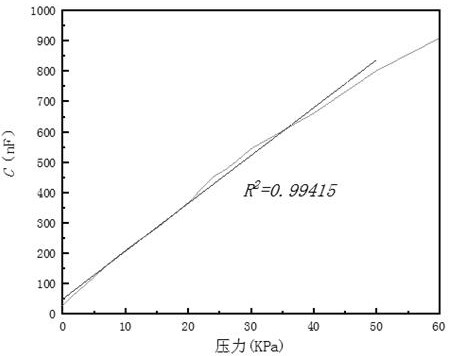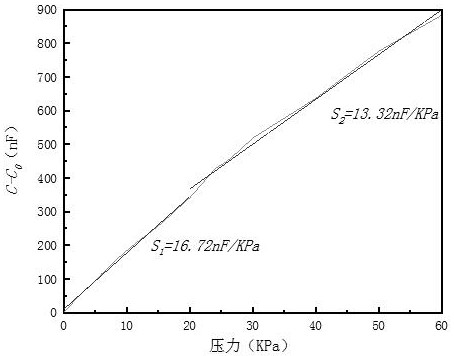Flexible capacitive pressure sensor
A technology of pressure sensors and flexible capacitors, which is applied in fluid pressure measurement, instruments, and force measurement using capacitance changes. It can solve the problems of polymer dielectric layer damage, environmental hazards, etc., and achieve low cost, good stability, and high efficiency. The effect of stability and reliability
- Summary
- Abstract
- Description
- Claims
- Application Information
AI Technical Summary
Problems solved by technology
Method used
Image
Examples
Embodiment 1
[0022] Embodiment 1: The flexible capacitive pressure sensor includes an ionic hydrogel dielectric layer based on a PVA substrate and activated carbon electrode layers arranged on both sides of the ionic hydrogel dielectric layer, wherein the ionic hydrogel dielectric layer based on a PVA substrate The first layer is to dissolve 1799 type PVA in water at 90°C, then drop the KOH-KI mixed solution into the solution with a dropper, keep stirring until the solution becomes transparent, finally add glycerin, stir and mix well, and mix The solution was poured onto a mold (using a silicon-based hydrophobic template with a groove thickness of 200 μm), vacuum defoaming, and drying at room temperature to obtain a film with a thickness of 90 μm. The mass ratio of PVA:KOH:KI:glycerin was 1:0.5:0.5: 1;
[0023] The activated carbon electrode layer is mixed with PDMS DC184 and PDMS SE1700 in a mass ratio of 1:10 to make a PMDS mixed glue, and the PMDS mixed glue is coated on a glass slide a...
Embodiment 2
[0030] Embodiment 2: The flexible capacitive pressure sensor includes an ionic hydrogel dielectric layer based on a PVA substrate and activated carbon electrode layers arranged on both sides of the ionic hydrogel dielectric layer, wherein the ionic hydrogel dielectric layer based on a PVA substrate The first layer is to dissolve 1799-type PVA in water at 95°C, then drop NaOH-NaI mixed solution into the solution with a dropper, keep stirring until the solution becomes transparent, finally add glycerin, stir and mix well, and mix The solution was poured onto a mold (using a silicon-based hydrophobic template with a groove thickness of 200 μm), vacuum defoaming and drying at room temperature to obtain a film with a thickness of 100 μm. The mass ratio of PVA:NaOH:NaI:glycerin was 1:0.5:0.4: 1;
[0031] The activated carbon electrode layer is mixed with PDMS DC184 and PDMS SE1700 at a mass ratio of 1:9 to make a PMDS mixed glue, and the PMDS mixed glue is coated on a glass slide an...
PUM
| Property | Measurement | Unit |
|---|---|---|
| thickness | aaaaa | aaaaa |
| thickness | aaaaa | aaaaa |
| thickness | aaaaa | aaaaa |
Abstract
Description
Claims
Application Information
 Login to View More
Login to View More - R&D
- Intellectual Property
- Life Sciences
- Materials
- Tech Scout
- Unparalleled Data Quality
- Higher Quality Content
- 60% Fewer Hallucinations
Browse by: Latest US Patents, China's latest patents, Technical Efficacy Thesaurus, Application Domain, Technology Topic, Popular Technical Reports.
© 2025 PatSnap. All rights reserved.Legal|Privacy policy|Modern Slavery Act Transparency Statement|Sitemap|About US| Contact US: help@patsnap.com



